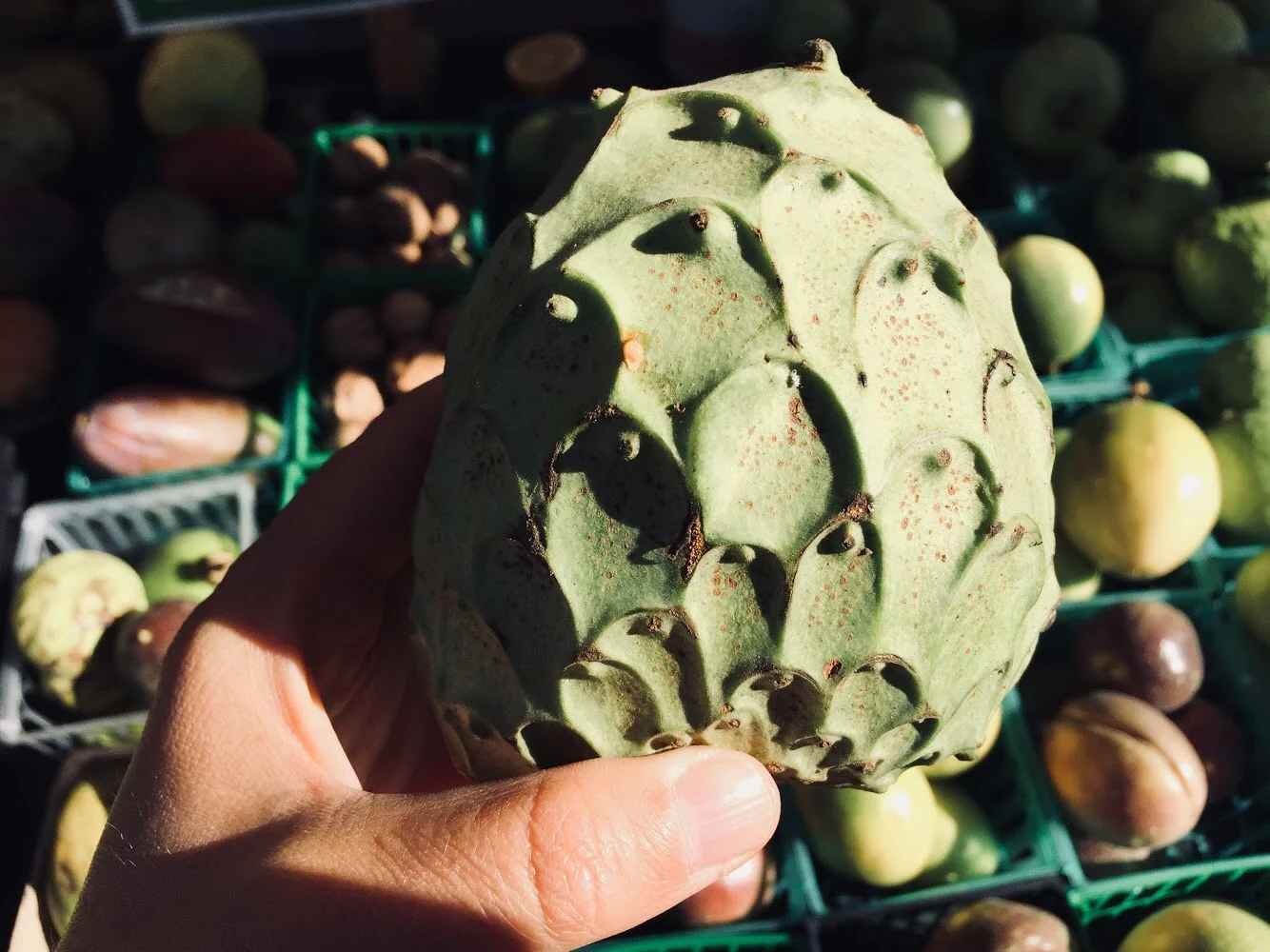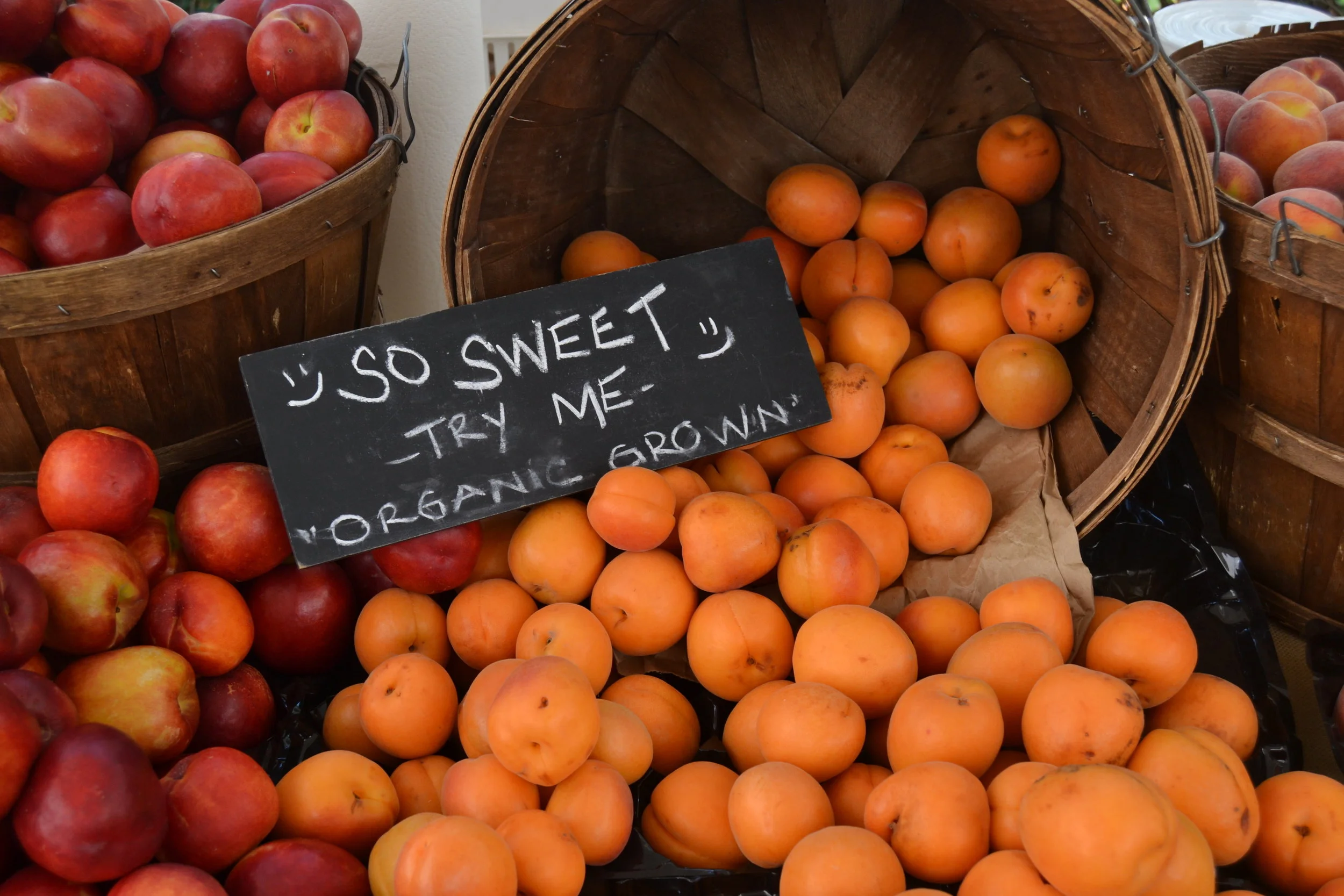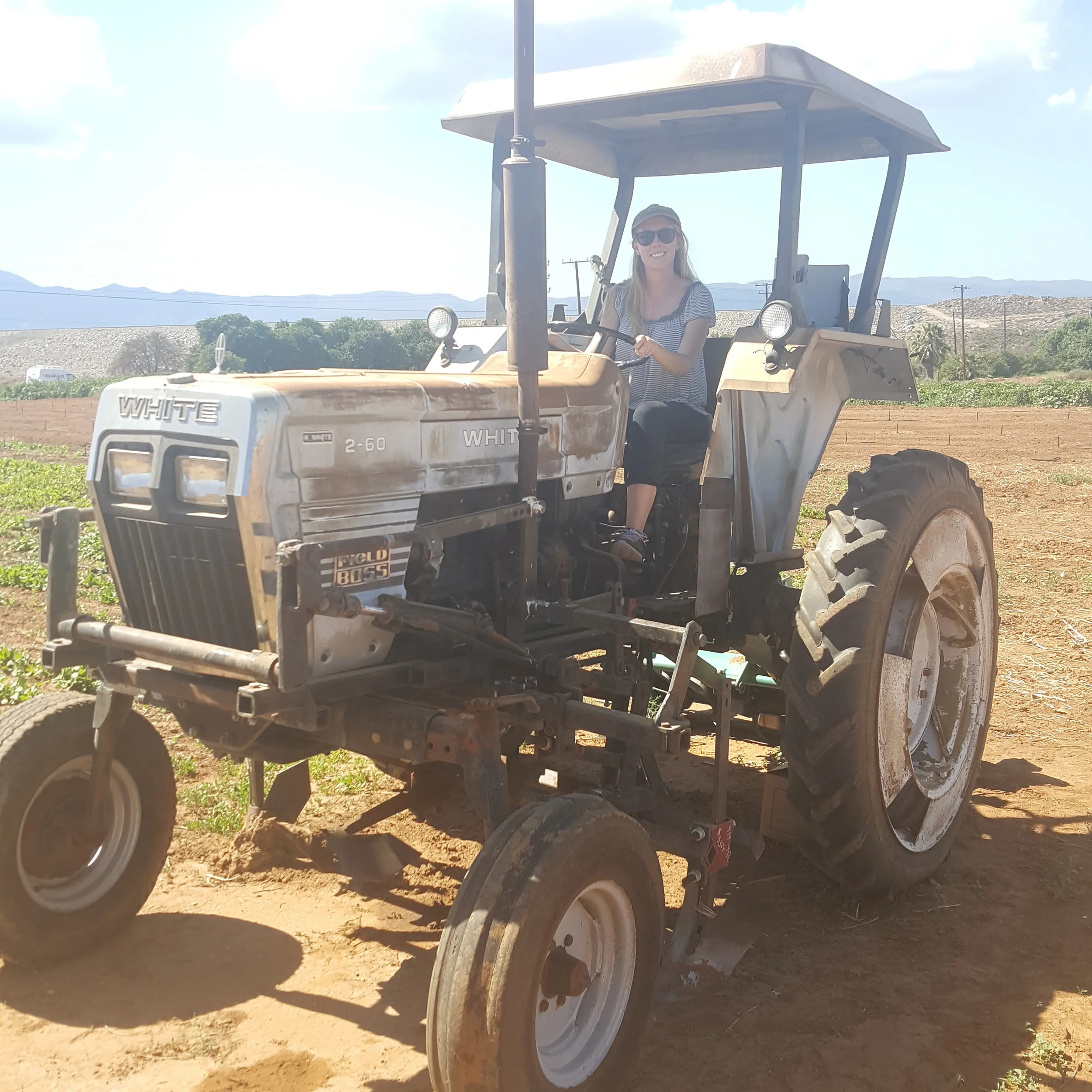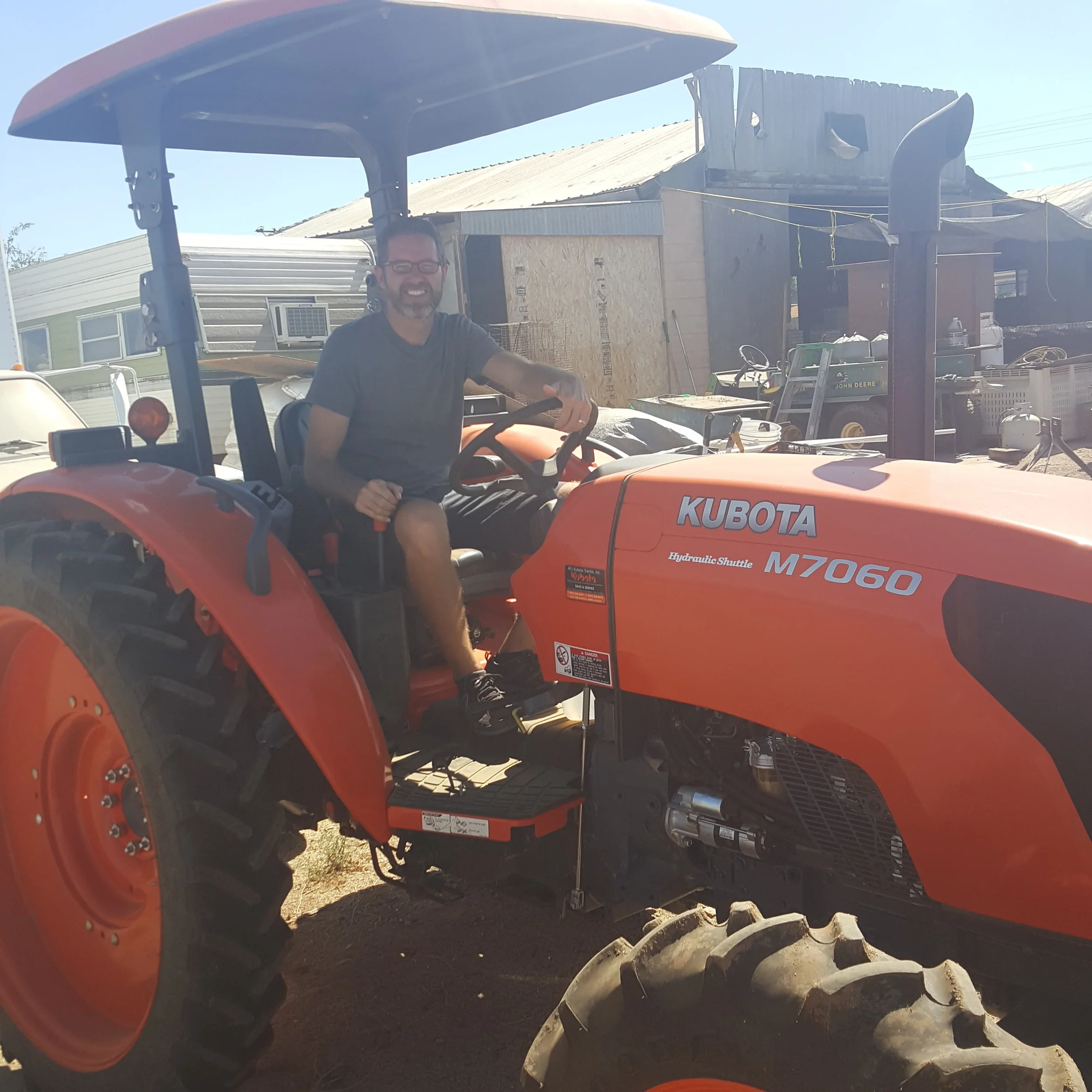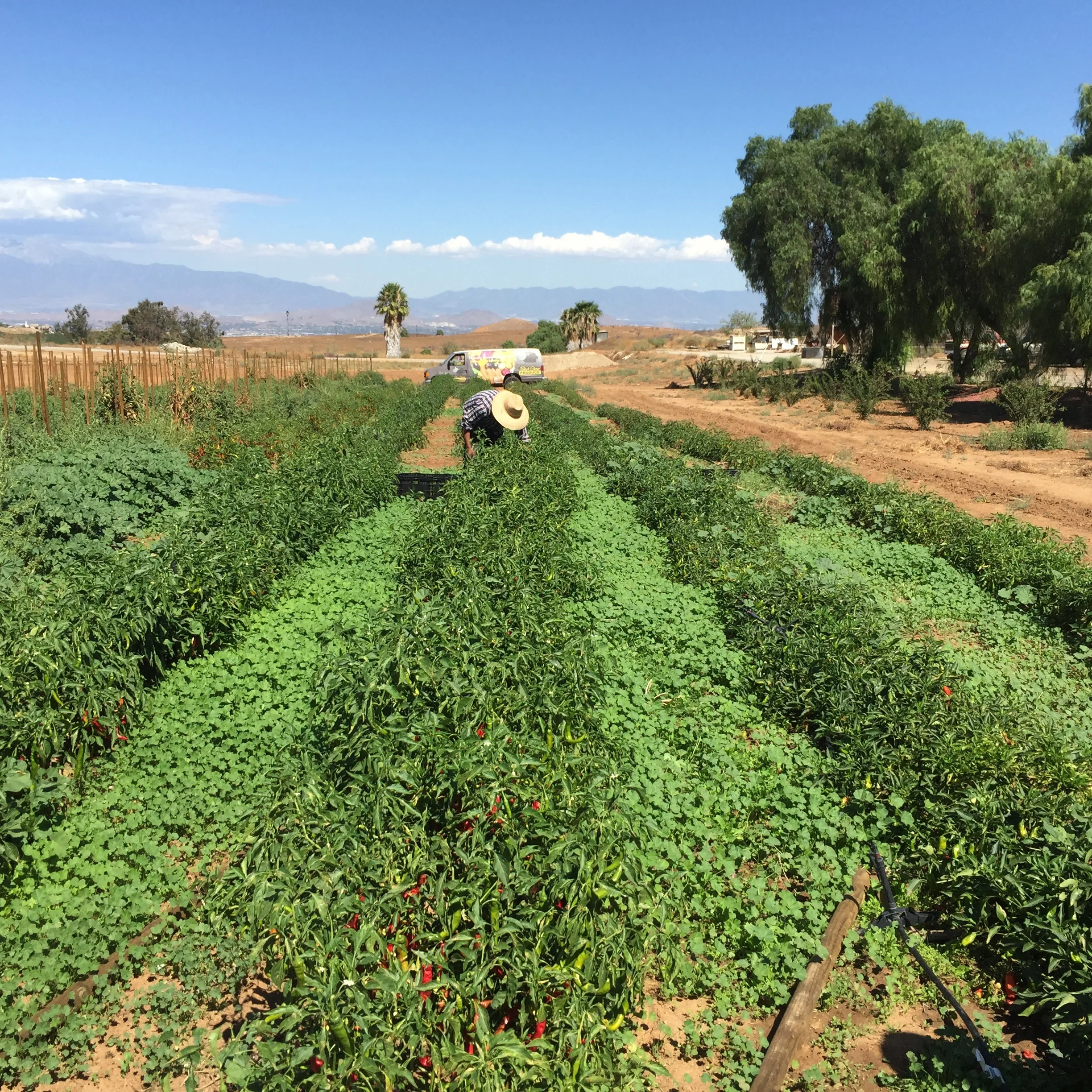New Year, New Perks
Our I Love My Market Card is putting market money in your pocket! Read more about how it works or stop by the info tent at the next market!
A New Year is a great time to build healthy habits! We at Farmer Mark, are here to help you turn your resolution into a lasting change. Introducing I HEART MY MARKET rewards cards!
Now, you can get an I Love My Market Card at our info tent at each of our market locations.
Pick up a card FOR FREE at the market. Get get your card punched each time you visit the market, and on your fifth visit, we'll give you $5 Farmer Mark Bucks, redeemable with any of our vendors!
When you have all 5 visits checked off, it’s time to get a new card and keep checking off visits!
How's that for encouraging your healthy habits?!
Recap:
5 visits = 5 Farmer Mark Bucks
Get your card punched each time you visit the market
Limit one punch per day
Once your card is full, grab a new one!
It’s our thanks to YOU.
Introducing Cherimoya: Your New Favorite Fruit
The Cherimoya fruit is the offspring of a hermaphroditic flower AND Mark Twain celled it "the most delicious fruit known to men. But that’s not all…
The cherimoya (cher-uh-MOY-uh) is a fruit of curious contradictions. It's native to cold, high altitude regions—of the tropics. In fact, its name comes from the Quechua word "chirimuya," which means "cold seeds," as the seeds germinate in altitudes up to six thousand feet. And that's just the beginning...
The flower that begets this fruit is hermaphroditic.
The flower that begets this fruit is hermaphroditic. It begins its life female and within a matter of hours, transitions to male. This f-to-m transition keeps the flower from self-pollinating. By the time the pollen is produced, the ovum has withered. Bees not are not pollinator for cherimoyas. In the wild, Scientists believe a beetle makes the match, collecting pollen from male stamens, and delivering it to female ovums before they transition. When they’re cultivated outside their natural habitat, each flower has to be pollinated by hand.
And it's worth it! This is a fruity-tutti tropical explosion! Mark Twain called the cherimoya, "the most delicious fruit known to men." We agree but, ahem, women like them too.
But steer clear of the seeds. They're poisonous!
You can find cherimoya at Pedro's Organic Ranch stand. Their season starts in late fall and runs through spring.
Aubrey Yarbrough is the Community Development Manager for Farmer Mark. Before moving to LA she ran her own organic farm and cooked on the garde manger station of the award winning Elements restaurant in Princeton, NJ. She has contributed poetry to New American Writing and prose to Edible Jersey.
Can Great Salsa Change the World?
Dina Feldman, chef and creator of Feel Good Salsa, makes mouth-watering, restaurant-worthy dips, but she’s not content to rest on the laurels of flavor alone. She also employs innovative, environmentally-conscious business practices .
If the sauce in question is Feel Good Salsa, the answer just might be yes.
Dina Feldman, chef and creator of Feel Good Salsa, makes mouth-watering, restaurant-worthy dips, but she’s not content to rest on the laurels of flavor alone. Dina wants her salsa to be good. Like, ontologically.
“I want to be the Patagonia of salsa!” says Dina. I want to prove that sustainability and profitability in business can coexist.”
Her fledgling company is only nine months old, but it has already taken big steps to ensure a small carbon footprint. For starters, her salsas don't travel far. Made in the South Bay, they are sold at Farmers’ Markets in Playa Vista and Costa Mesa. The produce is local too: grown between Riverside and Ventura: a 60-mile radius. This both limits their miles-to-market and provides sales for local farmers.
“I don't haggle with them,” Dina says. “Whatever price they give me, that’s the price I want to pay.”
If sourcing is important, Dina also thinks about where her produce will end up. In an effort to reduce her production scraps, she took cilantro stems, something normally tossed out as food waste, and turned them into a delicious dip.
“That’s been a huge hit because—obviously—it’s really awesome to use the entire cilantro.”
As for the onion skins, tomato cores, and pepper stems, the inevitable, inedible by products of salsa making, Dina composts them through the Bay Foundation’s “Table to Farm” composting program.
“We’ve [prevented] 200 pounds of food from going into the landfill,” she says with pride.
Instead of waste, these scraps become soil-enriching compost for Los Angeles-area farms and school gardens.
To Dina’s thinking, sustainability means carefully considering every step of production. The salsa is sold in biodegradable plastic containers. Dina’s market banner is made from recycled paper and eco-friendly ink, and her business cards are seed packets she made from recycled paper.
“I’m looking to find biodegradable gloves,” she says of the food service gloves required by the health department. “Being in business, you're going to create a footprint,” she concedes. “It’s almost inevitable, but I’m really focusing on lowering the carbon footprint as much as possible.”
Many entrepreneurs assume that sustainability will hurt their bottom line, but Dina is convinced that the opposite is true. She believes her standards give eco-conscious customers the opportunity to choose sustainability—or as she puts it, “vote with their dollars.” After watching customers flock to her stand, I think she’s right.
Feel Good Salsa flavors include (but are not limited to):
roasted chili de arbol
cactus pico de gallo
peach salsa
salsa verde
cilantro sauce
And all are available to sample. Containers are five dollars each. You can cast your vote Saturdays from 9am-2pm at the SoCo Costa Mesa Farmers Market inside SOCO & The OC Mix.
Aubrey Yarbrough is the Community Development Manager for Farmer Mark. Before moving to LA she ran her own organic farm and cooked on the garde manger station of the award winning Elements restaurant in Princeton, NJ. She has contributed poetry to New American Writing and prose to Edible Jersey.
What to Expect at the Market this Spring
With spring produce comes the promise of warmer months to come. Here’s a guide of what to look out for at the market this season, along with some tips on how to pick, store and cook your produce.
With spring produce comes the promise of warmer months to come. It allows us to start incorporating brighter green flavors and fresh vegetables to the hearty soups, stews and squashes that have kept us warm and nourished through the winter months. Here’s a guide of what to look out for at the market this season, along with some tips on how to pick, store and cook your produce.
Asparagus
In season March-April
Asparagus is a versatile vegetable that provides a great source of antioxidants. It’s also packed with nutrients that contain anti-inflammatory properties and support crucial bodily functions. At the market, choose firm stalks with closed tips and a moist base. Store them in the refrigerator like you would flowers by keeping their stems in water. In the kitchen, the applications for asparagus are endless: roast it in the oven, make it into a soup, cook it with eggs, put it in a risotto or grill it with olive oil, lemon and salt.
Green Garlic
In season March-May
We know that spring is here when green garlic, a younger version of the bulbs that most of us are used to cooking with, starts showing up at the market. Garlic is delicious, but its health benefits are even more of an incentive to include it in as many dishes as possible. It’s nutrients are known to protect the heart, strengthen immunity and support healthy joints. Choose bulbs of any size that are firm with no soft spots. Store your green garlic in the refrigerator, in a tightly sealed container. Use it as you would regular garlic, but expect a milder taste; put it in your braised greens, stir fry, or make a simple pasta sauce with olive oil and butter.
Grape and Cherry Tomatoes
In season April-July
A sign of what’s to come, these variations of tomatoes are bred to ripen earlier than the larger ones we look forward to in the summer. Tomatoes add a wonderful touch of acid to a variety of dishes. They’re rich in lycopene, which is a strong antioxidant that stimulates enzymes and deactivates carcinogens. Choose the brightest tomatoes without soft spots or wrinkles, and store them at room temperature to keep their flavor. They are delicious raw in salads, and they make a great pasta, meat or fish sauce when paired with olive oil and garlic.
Snap Peas
In season February-June
Also known as “sugar peas” or “snow peas,” these sweet, delicate and crunchy delights are a spring favorite for good reason. Snap peas are an especially good source of soluble fiber, which can help the body regulate sugar content (a perfect snack to go with all of the strawberries your kids are eating this season). They also require little to no preparation before they are ready to eat… a cook’s dream! Choose pods that are firm and crisp, not soft or bendy. If you feel your peas are lacking crunch, soak them in salt water or give them a quick blanch to revive their crispiness. Snack on them with yummy dips, or add them to dishes like grain bowls, salads and pasta just before serving.
Strawberries
In season March-May
Strawberries from the farmer’s market will taste so much better than what you could ever find at the grocery store. Although they’re available for most of the year in California, springtime is when their flavor really peaks. To choose your strawberries, pick the baskets that smell the best. You can refrigerate them, but they’ll taste the best if you enjoy them as close to the time they’ve been picked as possible. Combine them with rhubarb to make a springy jam, add them to salads with ingredients like snap peas and goat cheese, or have them with cream for a special treat.
Get it while you can:
produce heading out of season
- Artichokes
- Beets
- Blood oranges
- Chard
- Kumquats
- Pomelos
- Mandarins
- Sweet Potatoes
We’ll see you at the market!
Cheers,
The Farmer Mark Team
Microgreens...the new craze!
Microgreens are becoming the rage at local farmers' markets. Some are even calling them the "new kale". Farmer Mark interviews Farmer Joe of MicrogreensLA about why he thinks they are such an amazing superfood.
We love supporting local farmers and especially hyper-local farmers! We strongly believe the hyper local, urban farm movement is a necessity in strengthening our local food system. That’s why we are always proud to help new urban farmers, such as MicrogreensLA, launch into the farmers’ market world.
So what exactly is a microgreen? Good question. Here is how MicrogreensLA describes them:
Microgreens are tiny greens that are older than a sprout and younger than a full-grown plant. Microgreens are harvested after the first true leaves have developed. They are the smallest of the salad greens and herbs, smaller than the “baby greens,” and can be grown from almost any plant variety that would produce a mature edible plant, such as arugula, spinach, radish or basil.
Ok, they are very small (and kinda cute) but why should we buy them?
According to Farmer Joe Terry of MicrogreensLA, the nutrition story really sets them apart. 1 OUNCE of Microgreen Broccoli contains the equivalent nutrition to 24 ounces (1.5 pounds) of mature Broccoli florets. That's a 24-to-1 ratio. Talk about a superfood!!
Microgreens are usually grown in trays due to their quick turnaround and delicate nature. They germinate in soil or soil substitute, require sunlight for growth and are harvested when they’re seven to 14 days old and one to three inches tall. (For comparison, sprouts are seeds that germinate after soaking in water and grow for up to 48 hours before they’re harvested.) The flavor of microgreens is much more intense than that of mature greens. You can add them to salads, use them to garnish soups and sandwiches or just munch on them as a snack. Best to be eaten raw so as to not diminish the nutrient value.
Because of their youthfulness, microgreens don’t last long. Be prepared to eat them within 3-4 days.
Farmer Mark and Farmer Joe celebrating MicrogreensLA Organic registration.
Slow Food Nations
A foodie experience beyond words - being a delegate at Slow Food Nations 2017 in Denver. From a hands-on sourdough starter workshop, hearing a passionate talk from the founder of the movement (Carlo Petrini) and experiencing Alice Water's vision of school lunch as an academic endeavor. Join the Slow Food movement!
The response came back two weeks later to my application. I was selected one of 250 delegates from around the world to be part of Slow Food Nations 2017 in Denver. It was honor to represent Southern California. If you’re a die-hard farmers’ market foodie, you’re familiar with the Slow Food organization/movement. But don’t worry if haven’t. Although a worldwide organization, we are still just a small, momentum building movement.
What exactly is Slow Food? Easiest answer is “the exact opposite of fast food”. Slow Food’s principle food tenants are GOOD, CLEAN and FAIR. Food that nourishes the body, is available to all, and produced and retrieved in a way that’s beneficial to the farmer and to the eater.
Slow Food was founded by Carlo Petrini in 1986 in Italy after a demonstration on the intended site of a McDonald’s at the Spanish Steps in Rome. How did this group get their message across? By eating bowls pasta! A fitting gesture that symbolized the vast difference between Italian food traditions and the incoming wave of industrial food.
This festival brought together some of the best minds in the industry including: Food educators, advocates, enthusiasts, and influential guests from all over the world. 305 speakers, 70 exhibitors and 155 individual events. It was an inspiring foodie paradise. Some conference highlights included an interactive Sourdough Starter workshop, keynote address by Carlo Petrini and an inspiring lunch hosted by Alice Waters.
Learning the ropes about making (and caring for) your own Sourdough starter.
Chef Alice Waters, known for starting the original farm-to-table restaurant Chez Panisse, in Berkley, CA, is one of the most well-known advocates for improving school lunches through The Edible School Yard Project. Waters is on a mission to turn school lunch into an academic program. Brilliant idea that she brought to life during an interactive lunch at the conference. Check out Slow Food when you have the chance. Even better, participate in the movement.
A pre-lunch photo opp with two Slow Food legends (Carlo Petrini and Alice Waters).
All About Apricots
Fun facts about apricots. Did you know that 94% of all US apricots are grown in California?
Apricots! The sound of this delectable fruit reminds me of California summers. After all, California grows 94% of all apricots grown in the United States. Available for a short harvesting season, apricots are often the star piece of produce at markets during their growing season (May-August). The velvety outside and sweet and tart inside of this fruit is fulfilling not just in taste, but in nutritional quality as well.
There are over ten different varieties of apricots, the most common to California being the Blenheim variety. Like many crops, apricots thrive in California because of the ideal temperate climate here.
When selecting apricots, look for the following two important factors: color and firmness. The darker the orange color (or even red tinge) and firmer, the better. If your apricots are too unripe, they can be easily ripened in a paper bag at room temperature and out of direct sunlight. Apricots are classified as stone fruits (drupes) because of the pit inside. I personally like the smallest apricots (about the size of a golf ball). I think they are the tastiest because they often have the least amount of exposure to overwatering (and pesticides) in the growing process. Apricots are best preserved in a container placed inside a refrigerator. They will remain fresh for up to one week stored in this manner. A perfectly ripe apricot should actually twist open to break it in half, exposing the pit on one side. Note that unripe apricots will not ripen in the refrigerator.
Photo credit: diplomatickitchen
Apricots make a wonderful addition to oatmeal, breakfast cereal, ice cream, or even salads. They can be preserved for long-term use as jams, jellies, and chutneys. Popular desserts include cobblers or poached apricots. But, apricots can also star as the main course dish when prepared as a Moroccan chicken stew with olives or served as apricot glazed chicken. Dried apricots are often dehydrated. Best to seek out those preserved naturally (without sulfur).
Rancho La Familia Organic Farm Tour
A recruiting visit to the Rancho La Familia organic farm located in Santa Maria, CA (160 miles north of Los Angeles). Had the pleasure of a guided tour from the female farm owner herself, Virginia Cortez.
I recently traveled to the Central Coast to recruit an Organic farm to our group of markets. I had the pleasure of getting a tour of Rancho La Familia from the female farm owner herself, Virginia Cortez (pictured below). Her 48 acre farm is located near the heart of Santa Maria (160 miles from Los Angeles).
Virginia's father first started farming in the Central Coast as a sharecropper. He was fortunate to have a supportive landowner who encouraged him to purchase some of the land and start his own farm. Virginia has kept farming in the family, which includes several relatives involved in farming as well as a few of her children.
Rancho La Familia has an amazing organic selection of berries, cruciferous vegetables, onions, beets, and other seasonal veggies.
Organic berries are often tough to find, especially at local farmers' markets as growing them organically is difficult and risky venture (loss of crop if pests get out of control). They are always a hot item for those that follow the EWG's Dirty Dozen where strawberries almost always top the list of pesticide residues. So how does Virginia handle the pests she encounters? The biggest weapon is diligent monitoring of the crops to address pests at the earliest stage possible. She walks her fields every day (multiple times) to keep a close eye on things.
Her next weapon is a vacuum. Yes, a vacuum. A big vacuum. Twice a day the tractor below with the vacuum attachment gives the strawberry fields a once over.
Another technique she uses to keep some pests and critters away is interplanting with onions. The harsh flavor of the onions keeps some of them away. Organic pesticides and insecticides are also part of the regime. Neem oil is one of the more common ones used.
Farm Tour: Black Sheep Farms
There is not much more enjoyable than a farm tour. It is a great feeling to see the pride in a farmer’s eyes as they show off the land on which they grow food. It is also a humbling and grounding experience to see all that is involved in the start of the farm to plate journey. Learn about our visit to Black Sheep Farms of Riverside.
There is not much more enjoyable than a farm tour. It is a great feeling to see the pride in a farmer’s eyes as they show off the land on which they grow food. It is also a humbling and grounding experience to see all that is involved in the start of the farm to plate journey.
Edgar Jaime, owner, gave us a tour of Black Sheep Farms. Edgar currently grows on two leased parcels (totaling about 10 acres) in Riverside. Black Sheep Farms is a specialty grower for restaurants and farmers’ markets. Edgar likes to focus on varieties that local restaurant chefs seek. If the chefs haven’t gobbled up all his production, you’ll find specialty items such as mini sweet peppers, watermelon radishes, flying saucer squash and heirloom tomatoes adorning his farmers’ market table.
Edgar Jaime educating Farmer Mark about his production.
Edgar grew up in a farming family. His father immigrated from Mexico and worked at a farm growing Asian produce before starting his own farm. Edgar’s siblings chose the farming life as well. However, it wasn’t Edgar’s first choice. He graduated college with a BA in Business and pursued the business world before the economic downturn of 2001 made him rethink his farming roots. He returned to work with his father and quickly realized the opportunity in growing specialty produce offerings for sales to chefs (via wholesalers). Eventually, Edgar branched off from the family farm and started Black Sheep Farms on his own. A name derived from his decision to stray from the family farm.
Tasting a freshly picked ripe watermelon from the vine. Very refreshing in the 95 degree heat.
Like many small farmers, Edgar hopes he may be able to purchase some land of his own in the near future. Cost and water access are major hurdles in this goal. He recently had to upgrade his 1973 tractor for a new one. No small act with a new one going for around $40k.
Although Edgar currently follows organic farming practices, he is not permitted to call his produce Organic without USDA Certification. (Read more about Organic) He has applied for organic certification with CCOF and is in the transitional period.
Farmers Market 101: Market Tips
There are many tips and tricks to smart shopping at the farmers’ market. These tips allow you to get the biggest bang for your buck, and have the best experience possible. We’re letting you in on a few of our top tips. Keep these in mind next time your shopping at your local farmers’ market.
There are many tips and tricks to smart shopping at the farmers’ market. These tips allow you to get the biggest bang for your buck, and have the best experience possible. We’re letting you in on a few of our top tips. Keep these in mind next time your shopping at your local farmers’ market.
- Early Bird Gets the Worm: This is one of our most important tips. If the market opens at 9, get there at 9! Being one of the first customers will allow you to pick from the farmers’ full selection. You might be missing out on an incredible item that always sells out within the first hour.
- Go Big: Why not buy a whole flat of tomatoes or strawberries? If one of your favorite fruits or vegetables is in season and is looking juicy and delicious, go for it. You can always freeze or can them! Buying in bulk can often come with a nice discount. Politely ask the farmer about bulk deals available.
- Experiment: We all have our favorite farmer at a specific market, but don’t forget to explore. Challenge yourself to try at least one new vendor each week at your market. You might just find your new favorite item.
- Get Friendly: Farmers sell at the market not only to share their crops, but to get to know their customers! They love interacting and answering your questions, so don’t be shy! If your curious about their farming practices or what a certain crop is, go ahead and ask them! TIP: Remember your vendor’s name the following week and greet him with a friendly, “Morning, (insert name)!”
- Bring the Green: Most farmers operate on a cash only basis, so don’t forget to stop at an ATM before heading to the market. And keep in mind that small bill work best.





